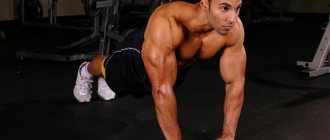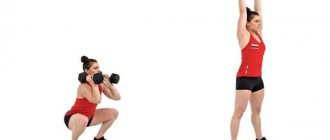What is fitness
Benefits of Fitness
The harm of fitness to human health
Contraindications for fitness
Types of fitness
Many people understand fitness as hard physical training in gyms or stadiums, which is aimed at strengthening the muscles of the entire human body. But in fact, fitness includes training the heart and blood vessels, training designed to increase the flexibility of the body. There is also a sport called fitness.
What is fitness
The word “fitness” is derived from the English word from the verb “to fit”, which translated into Russian means “to fit”, “to be in good shape”.
Fitness is almost any type of physical activity that allows the human body to be in good athletic shape.
In general, fitness is divided into general and physical. General fitness means achieving harmony with yourself, both physically and spiritually. Physical fitness already includes a wide variety of exercises for training strength, endurance, respiratory and cardiovascular systems. There is a type of fitness that allows you to lose extra pounds and lose weight. This type of fitness is called aerobic.
What is fitness?
Like any self-respecting specialist, I am not looking for simple formulations to designate my field of activity. And I don’t think I know everything! Moreover, this sphere is very large and diverse. And it affects the most important values in the life of any person: health, life expectancy, physical attractiveness, physical performance, personal effectiveness, education, general culture, etc.
Therefore, my answer will be quite voluminous, professorial, if you like. After all, complex things cannot be explained in two words.
It is important to understand that fitness is not synonymous with fitness clubs. A fitness club is a place where you have the opportunity to use some types of fitness equipment.
Fitness is a big cultural and scientific phenomenon. You can't touch it with your hands! But you can and should use its power.
The concept of fitness is still too young to have ready answers to all questions. In fitness, even the terminology has not yet been established. Especially in Russian. And many fitness exercises have very unstable names. You literally have to come up with them on the fly in order to somehow explain them to a client or colleague.
Chemistry and physics now have answers to almost all questions. In fitness, everything is just beginning. Fitness is a science developing right before your eyes. Often going through ugly wild market phases.
Benefits and harms
The results that Antigravity can achieve come after the first lesson. Aerial yoga:
- normalizes blood circulation;
- reduces the risk of heart disease;
- improves digestion processes, therefore suitable for weight loss;
- prevents the aging of the body;
- stretches the vertebrae;
- makes joints more flexible and mobile;
- reduces pain in all parts of the spine;
- strengthens muscles;
- reduces tension;
- relaxes the body and increases its endurance;
- improves mood;
- enhances the production of endorphins;
- helps fight depression;
- improves the functioning of parts of the brain;
- increases harmony of body and mental state.
Almost all Aero Yoga exercises are done in the air, so the pressure on the spine is reduced and flexibility is increased. Regular yoga classes improve your mood and improve your outlook on life.
Legendary meditation course without payment We recommend! The most popular meditation course for beginners in Russian. More than 100 thousand people have already learned to meditate. Try it yourself. Read more.
Aerial yoga asanas are not recommended if you have:
- illnesses associated with colds (high fever, sinusitis, etc.);
- advanced pregnancy;
- head injuries;
- complications in the gastrointestinal tract;
- menses;
- uncomfortable state of the body during the lesson.
There is also a list of prohibitions. You should not practice this type of yoga if you have:
- high blood pressure;
- varicose veins;
- thyroid diseases;
- thrombophlebitis;
- retinal disorders;
- displaced vertebrae;
- intervertebral hernias.
In all other cases, it is important to consult with your doctor and trainer.
Important! It is better to practice Aero Yoga in specialized gyms or yoga studios, under the supervision of an instructor.
Fitness is a system
Fitness is an interdisciplinary thing. Modern fitness is a system that incorporates the best and most interesting from many sports, physical education, medicine, physiology, dietetics, and psychology. Bodybuilding, Pilates, all types of aerobics, stretching, kettlebell lifting, weightlifting, sports games, martial arts, yoga, dance styles, sports medicine, rehabilitation - all this has enriched fitness with methods and forms of training the body and spirit. Various applied disciplines show themselves very well here: military science, professional sports, martial arts, meditative techniques, etc.
So what is fitness? This is a system assembled from various elements that are taken from well-known sports. These elements are constantly studied, sorted, classified and summarized. The result is very useful and powerful techniques.
But within the framework of fitness, new methods and forms that are not typical for most sports, new exercises and training systems are also developed (often spontaneously, literally on the street). Take the same crossfit, parkour or street workout.
Fitness is exercise
Exercises are the direct embodiment of fitness ideas. This is the kind of fitness that we can literally see and feel. We directly perform the exercises to get a response from the body. What this reaction will be depends on the exercises and the system in which they are built. If there is no system, the result of the exercises will be unpredictable.
What is fitness? Exercises.
There are a lot of fitness exercises, thousands. They can very roughly be divided into several large groups (my list is far from complete):
- strength exercises
- cardio exercises
- flexibility exercises
- speed exercises
- coordination exercises
- endurance exercises
- special exercises
I will tell you in more detail about each of these types of exercises gradually in publications on the site. But remember the main thing: all exercises are divided into groups conditionally. The same exercise can (with slight modification) be used for different purposes, sometimes opposite ones. And one exercise can develop many qualities at once.
The most useful exercises on simulators
Basic exercises
Aero yoga includes about 300 varieties of asanas and exercises.
It includes a symbiosis of classical oriental knowledge, fitness, acrobatic and gymnastic elements. This combination helps to achieve good results in a short time. The training program is developed by the trainer taking into account the characteristics of the person, the chosen direction and the desired result. Movements can be performed with support on the floor surface or without touching it.
Inverted asanas (head down) become important in Aeroyoga. To perform such exercises, you need to practice. You should switch to such asanas only after 2-3 preparatory classes.
Scheduled workouts
Order and regularity are key points in the fitness method. All classes, training and rules must be organized and repeated regularly. Ideally - at the same time.
Long-term fitness planning is a very important and beneficial element of a healthy lifestyle. The plan must be individual, taking into account the characteristics of a person’s life, his professional activity, level of health and physical fitness. The plan must take into account all the strengths and weaknesses of a particular person. And the training system is built in such a way as to gradually improve weak points and improve the necessary parameters. This will inevitably lead to significant improvements in health.
How is fitness different from other types of training?
Many people who are just planning to start fitness classes often confuse fitness with other sports. Some people think that fitness classes are carried out in the gym, others think that fitness and bodybuilding are the same thing, and others are confused about the different areas of fitness. To clear up the confusion, let's look at the most common misconceptions.
What is the difference between fitness and aerobics ? These areas are actually quite similar to each other, however, fitness is much more complicated and requires the supervision of a trainer at the initial stage. Fitness is the best way to shape your figure, but aerobics is more aimed at maintaining health, including the lungs. The set of exercises in these areas is also different.
What is the difference between fitness and shaping ? Fitness is a more comprehensive area, designed not only to correct the figure, but also to improve health and adherence to the rules of a healthy lifestyle. The task of shaping is to correct the figure. Also, both men and women can engage in fitness, and shaping is intended exclusively for the fair half of humanity.
What is the difference between fitness and bodybuilding ? The goal of bodybuilding is to build muscle mass, but when doing fitness, such a goal is not set; it is only important to improve the overall muscle tone.
What is the difference between fitness and a gym ? The difference between fitness and the gym is about the same as from bodybuilding - the goal of working in the gym is to build muscle mass, and fitness is aimed more at burning excess fat.
What is the difference between fitness and Pilates ? Pilates is a set of static exercises aimed at improving posture, flexibility, and stretching. Fitness classes are much more dynamic.
What is the difference between fitness and sports ? Fitness is a certain way of life, and sports are competitions; You do fitness for yourself, and sport implies great responsibility.
We hope that now the word “fitness” has ceased to be something unfamiliar and mysterious to you, and you have also learned how it differs from other types of training. To relax, you should try MFR training. If regular sports seem boring to you, you can try bungee fitness. And now you can start the classes themselves!
Fitness is about control
Medical before you start training. This is a banal physical examination and simple medical tests.
Coaching – when you need to evaluate the initial data, understand the directions of human development. These are fitness tests for strength, endurance, flexibility, posture, etc., allowing the trainer to understand which areas of the body need to be given a certain amount of load, so as not to work blindly.
Intermediate – when you need to evaluate the effectiveness of actions and training. This means regularly conducting tests and testing competitions to ensure that progress is being made in the right direction. If intermediate tests show a lack of progress, you need to change the set of exercises or type of load. Or a way of life. See Fitness Test. What shape are you in? Cooper tests.
It’s absolutely impossible without control! In fitness, collaboration between a doctor and a trainer is common. And control gives the client a clear picture of the changes. I think it's obvious.
Proper nutrition
In fitness, great attention is paid to proper nutrition. There are a lot of nutrition systems and different diets. But decent and adequate nutrition systems like the Mediterranean diet and the paleo diet are gradually crystallizing. Based on them, smart nutritionists and trainers build nutrition systems for clients.
Within the framework of fitness, the most appropriate principles of nutrition have already been identified for various purposes: gaining muscle mass, losing weight, maintaining a normal weight. Professional trainers and sports nutritionists are proficient in them.
Proper nutrition. Basic principles.
A separate topic is sports nutrition. In fitness, it is customary to actively use various sports nutrition products: proteins, gainers, vitamins, amino acids, mild stimulants, energy restorers, beneficial metabolites (like creatine, ornithine).
How to choose sports nutrition and how to take it
Types of aerobics and their characteristics
There is no generally accepted work on the topic “types of aerobics and their classification.” Globally, aerobics is differentiated into high and low intensity classes . High intensity is a pulse of 60% of the maximum heart rate and the presence of jumps in the program. Although the latter is not the rule. Cycling and trekking eliminate shock loads, but “twist” your heart rate to the maximum. Low intensity is 50-60% of maximum heart rate.
The maximum heart rate for fitness is calculated using the formula “220 minus the client’s age.”
High intensity activity is:
- Step, except for beginners classes.
- All types of fitboxing, kickboxing and pilox.
- Zumba.
- Lessons on trampolines.
- Kangoo jumps.
- Hip-hop and jazz-funk.
- Break.
- Speed running, sprint.
- Group functional training lessons.
- Short interval training combining strength exercises and jumping.
- Almost everything that is given at online marathons with burpees and jumping jacks.
Low-intensity yoga includes almost all types of fitness yoga, except for power yoga and options in a heated room, Pilates, non-impact aerobics with choreographic combinations (aerodance, aerobix), all types of fitness ballet, walking on a treadmill and on the street.
Swimming can be either high-intensity or low-intensity - it depends on the skill of the swimmer and the speed of his movement.
Please note: the main characteristics of an aerobic lesson are the presence or absence of jumping and the client’s heart rate. Whether there are dance routines or not, what kind of music is used, whether strength exercises with small equipment are introduced or not are not so important.
A short cheat sheet to choose from:
- There should be no contraindications. Obesity from the first degree, diseases of the joints, spine, heart - definitely low-intensity types.
- You must like the lesson. No violence, no one will learn ligaments and suffer for hours if it’s just unpleasant.
- You need to exercise no more than 2.5-3 hours a week, otherwise you will have to significantly increase your calorie and nutrient intake in order to recover.
© diignat — stock.adobe.com
Wellness
All types of aerobic classes are designed as health-improving ones. But there is also a competitive discipline - sports aerobics (more about it below). Teams compete in it and quite complex jumping and acrobatic elements are used.
The term “health aerobics” means regular aerobic fitness. The general recommendation is to attend classes 2-3 times a week, do not overtrain, and monitor your heart rate.
The main types are in any club:
- Step is steps, jumps and dance sequences on special platforms. Students repeat after the instructor. At the end of the lesson there may be a small power section on “problem areas” - hips, buttocks, abs or arms.
- Zumba - dancing to Latin, pop and even elements of hip-hop. Designed to target problem areas, burn calories and keep you from getting bored. The instructor does not come up with the movements himself, but is trained according to a certain centralized program.
- Fitbox is an imitation of boxing and kickboxing punches on a punching bag. Gloves and punching bags that are softer than in martial arts are used. There are also “dance” sequences - moves, steps, sometimes moving around the hall.
- Tai-bo is a lesson with punches and kicks in the air, without punching bags.
- GRIT – functional training with burpees, dumbbell swings, combined strength exercises.
- Circuit training - usually squats, lunges, push-ups and various arm and back exercises with small equipment. In terms of metabolic activity, they are not comparable to strength ones. They include only the aerobic mode of work in the body.
- Interval lessons - may include alternating strength training and jumping, as well as a minute under power load and two minutes of light steps. There are no standards; the instructor builds the load independently.
- Funk and jazz-funk are two trends from the late 90s of the last century that have become popular these days, thanks to the fashion for that era and the corresponding music. They are dances very similar in style to hip-hop.
Separately, Pilates and yoga can be distinguished. Their fans will never admit that this is also aerobics, but they work “slow” muscle fibers and require an influx of oxygen.
Applied
Applied aerobics refers to activities that are used as an element of training in various sports and as an element of various shows and productions. For example, if a person is engaged in fitness in the gym with the goal of building muscles, aerobic exercise on a treadmill or dancing on Zumba will be useful for him.
Important: a simple diagram will help you choose the type of applied aerobics. If the main load is strength, aerobics should be less intense and, if possible, without hitting the punching bag with your hands and feet. If the goal is to lose weight, there may be a shift towards “aerobic-strength” exercise such as group lessons. In this case, you can include more intensive lessons.
The rules are:
- If the goal is weight loss, strength training is done in 12 working approaches for each muscle group and a person does a split 3-4 times a week, applied aerobics can be belly dancing, Zumba, a version of cycling, trekking with a medium load, or step for beginners.
- If, when losing weight, strength training is performed in a circular or functional style, it is better to avoid aerobics in groups. Your choice is a treadmill, exercise bike or elliptical with a heart rate of no more than 70% of the maximum.
- If a person does not work out in the gym and does not plan to do so, but wants to lose weight, the choice is almost free, 3-4 hours a week in the aerobic gym with a load of medium to high intensity.
- If the goal is to gain muscle mass and shape your figure, the most effective aerobics is low-intensity walking 2-3 times a week for 30 minutes. It will slightly increase calorie consumption, strengthen the cardiovascular system and improve recovery after strength training.
Is it possible to build a beautiful figure with aerobics only? Depends on the ideal, of course. If someone is aiming for a fitness model shape, he or she needs strength. Are you just satisfied with slimness, small lean muscles and your own proportions? Welcome to group aerobic classes and don't forget about a smart diet.
Important: aerobics is not “for weight loss.” It improves health and increases calorie expenditure. But whether a person will lose weight or not depends on his eating style and the number of calories consumed.
Sports
This is a competitive discipline. It is recognized by the Ministry of Sports of the Russian Federation. Titles are awarded and competitions are held. There are sports aerobics sections in large cities, at sports schools and universities.
Athletes compete in performing a set of exercises, which may consist of:
- longitudinal and transverse twines;
- various jumps;
- falls from the rack and exercises on the floor.
It is an artistic discipline, like rhythmic gymnastics. Technique, physical aspects and aesthetics are assessed comprehensively. The teams are formed by the athletes themselves or their coaches. There is no standard. Judges use a special point scale to identify winners.
There are age groups, adult participants compete in one - over 18 years old. In addition, competitions are held in divisions:
- individual;
- in pairs;
- in triplets;
- in groups.
This sport is not the most popular, teams often live on enthusiasm, but sports aerobics classes develop strength, flexibility, endurance and build a beautiful athletic figure.
Fitness mistakes
An extremely important topic! Every professional should know common mistakes and be able to avoid them. I think a registry of common fitness mistakes should be created and shared. This will immediately solve a lot of problems associated with illiteracy in the field of fitness and sports training.
I discussed some of the errors in the articles:
Harmful exercises to health The most important mistakes in developing flexibility How to exercise correctly in the gym The stupidest misconceptions about a healthy lifestyle
Fitness is a healthy lifestyle
Fitness has its own very clear criteria for a healthy lifestyle:
- giving up bad habits (smoking, drugs, alcohol, stimulants)
- healthy diet that corresponds to energy consumption and climatic conditions
- adequate rest and sleep at night
- normal working conditions, rhythms of activity
- healthy relationships with others
- constant concern for one’s own development and education
Without these aspects, any training and exercise is completely meaningless. The often encountered work schedule “every two or three days” or a rotating work schedule - this almost completely excludes normal life and fitness activities, since it disrupts the normal physiological rhythms of the body.
Education and self-education
Fitness classes are very fertile ground for raising children and adults. Performing fairly complex exercises according to the rules and schedule is very disciplined, teaches you to calculate your strength and comply with the necessary requirements. It is not easy! But it is extremely effective.
After such a school, a person quickly adapts to any work and service. Isn’t this the key to successful activity, study, business?
Fitness can easily become a state-standard physical education system.
Harm of fitna
Muslims should avoid both obvious and invisible troubles and temptations that hinder a person’s path of Islam, and this may include family, work, and wealth. A Muslim should avoid troubles and temptations, because their evil can engulf oppressors and troublemakers and spread to the righteous.
A Muslim should be careful in everything that affects his beliefs: a believer must protect himself from unrest, especially when it comes to unrest in ideology or aqida and from unworthy behavior and erroneous opinions. Troubles can be compared to a contagious disease that spreads rapidly and affects not only the hearts, and not only the actions of people, but also entire communities. Such a disease leaves its traces on both the benefactor and the villain, and its result is always disastrous.
In Islam, delusions and temptations are compared to hopeless darkness, which is devoid of any light, because they are capable of influencing the beliefs and faith of a Muslim so much that a person can change in a short period of time: from a believing Muslim, a person can become an infidel. In Islam, those people who have weak Iman (faith) are subject to the influence of fitna due to their sins, due to the fact that they themselves indulge their lusts and desires. Such people are not able to resist temptations - their temptations are able to hit the way an arrow hits its target.
Fitness and age
There is currently no convincing evidence that exercise prolongs life. However, there is a lot of convincing evidence for prolonging the active period of life. When a person in old age keeps himself in good shape, he can do a lot outside of fitness. If you have an efficient body and a lot of useful habits, you can work a lot and bring real benefits until a very old age. Does anyone still dream of retiring quickly so they can lie on the stove all day long? I can hardly believe this!
What is fitness for older people? This is the physical basis for an active life until the last days.
Fitness in old age
Protection from fitna
People should fear temptations and turmoil in the same way as epidemics and infections, since they are much more dangerous for religion than the death of the body, because temptations and turmoil destroy souls. Prophet Muhammad ﷺ warned his community against fitnah , calling on them to stay ahead of troubles with their good deeds.
Modern human society is subject to a lot of temptations, and at the moment when sin first appears, the believer has the strength and wisdom to renounce sin. But as time passes, the hearts of some of them soften towards sin, and then a new temptation appears, and this next one will be even heavier than the previous one. Anyone who has not been tested by temptation can safely call himself happy. The one to whom such a test was sent must show patience and perseverance.
Fitna should not make the believer weak: the servant of Allah must be God-fearing, he should not be deceived by temptations and succumb to seduction. The religion of Allah, Islam, remains unchanged throughout time, and only Islam forever remains a clear guideline in the life of a servant of God.
A believer must constantly turn to Allah with a prayer to protect him from hidden and overt trials, to save his slaves from the torments of Hell and to help him withstand the test against temptation.
Islam is the stronghold of the believer’s entire existence, a guideline in the structure of worldly life and a guarantor of overcoming fitna and a future good life. During worldly life, a believer accumulates everything good and good, and death delivers him from the bad, the evil, from fitna.
Fitna in Islam is something from which a Muslim asks Allah to deliver him in his supplications and prayers.
Allah in His Holy Book calls on believers not to think on a par with sinners and not to be like them. Islam contains everything that is necessary, that is useful for a person, and one should not be deluded by what another culture offers. The Koran, the Sunnah of the Prophet Muhammad ﷺ gives answers to all questions, indicates the right path and helps to avoid fitna in the life of a Muslim.
If a person turned out to be weak, turned out to be powerless against fitnah and followed the lead of those who preach debauchery, then the only way for him to be cured in Islam is to turn to the Sunnah and the Koran, take an example from the path of the Companions, and these sources will clearly show what Allah has sent blessings to Muslims, and what are the enemies who are calling for unrest and fitnah going to deprive Muslims of?
In order to protect yourself from troublemakers, you should be persistent and not reveal weak points, because it is precisely on weak points that those who try to instill provocative values that are alien to them carry out their work on Muslims. Following the laws that Islam establishes is the only way to gain strength and strengthen your beliefs. The laws of Islam are reliable laws; they were conveyed to Muslims by the companions of the Prophet Muhammad ﷺ. Adhering to these laws, the Muslim world expanded from east to west, acquiring the treasures of the Byzantine kings and the Persian Khosroes, who ensured the path of Allah. Only the fact that Muslims held tightly to the Sunnah and Quran helped Muslims to stay on the righteous path.
Fitness and modern technology
In our time of gadgets and mobile applications, it is simply a sin not to use technology in order to improve the quality of life and activity. And fitness classes in particular.
There are many useful applications and services that allow you to collect training statistics (heart rate, load, duration and frequency of training, etc.). However, the accuracy of such applications and gadgets leaves much to be desired. Hopefully this will all get much better soon.
Many applications offer ready-made training programs. But according to my observations, they are still far from ideal. Most often, applications are created by people who are very far from methodological developments in fitness. Therefore, the technical part of the application may be ideal. But fitness there, frankly speaking, is of a very low grade. The key to success here is the collaboration between app creators and real experts.
Personally, I still prefer to measure my heart rate manually. This is always more accurate than measurements using even the smartest watches and heart rate monitors. And I keep a training diary in a notepad or in a file, and not on the smartphone screen. It's just more convenient for me personally.
How is the training going?
Typically the lesson lasts about an hour and is divided into six steps. The training begins with breathing exercises.
Then the muscles and ligaments (neck and joints) are warmed up. After this, you can move on to asanas using a hammock. The first exercises are based on the floor surface. At the end of the training, asanas are performed in air space: a slow transition from simple exercises to inverted poses. At this stage, increased concentration and physical preparation are required. Beginners come to such exercises gradually. The last stage of the training is relaxation during meditation. This helps remove tension from the muscles and tune in to positive thinking.











